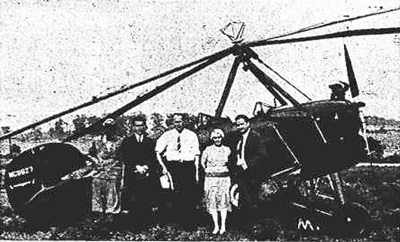
1
Left to right: Peter Barton, pilot; Mr. Herbert, salesman; O. G. Smith of Livonia; Mrs. H. W. Trott and Dr. H. W. Trott of Hemlock.
The first autogiro plane to be demonstrated in this town dropped gracefully from the sky Monday afternoon onto the field at the Hemlock airport. Since 2 o’clock the eastern horizon had been scanned to catch the first glimpse of this odd looking machine which, like others of the same type, are said to be the forerunners of safer and more general flying.
Piloted by Peter Barton, a flyer of the old school, with a salesman of Pitcairn Aircraft, Inc., of Willow Grove, Pa., as passenger, the plane left the field of the Westchester Air corporation at Armonk, Westchester County, at 10:30 Monday morning, and landed on the Hemlock field at 3:30. Heavy fog delayed them at first, and they were further handicapped by a headwind which at times was as heavy as twenty-five miles an hour.
As soon as the plane was sighted, the number of men and women and boys who had been awaiting it on the field was augmented by a considerable crowd. The pland was inspected in detail and the pilot and salesman were plied with a great variety of questions, all of which reminded one of the sensation created by the automobile when it first made its appearance.
The initial passenger to go aloft Monday in a demonstration flight was Mrs. H. W. Trott of Hemlock, whose husband is largely responsible for the local interest in aviation. Oscar Smith of Livonia and Dan Oster of Hemlock were also taken up in the plane Monday. Mr. Barton and Mr. Herbert left late in the afternoon for Rochester.
The autogiro plane has been under production for actual sale only six weeks, for it was only six weeks ago that the Pitcairn Aircraft Co. of Willow Grove, Pa., the Buhl Aircraft Company of Detroit and the Kellett Aircraft Corporation of Philadelphia received government licenses permitting them to manufacture for commercial purposes. The machine which was at Hemlock is one of two models made by Pitcairn, and is driven by a Kinner radial type, five-cylinder, 125 H.P. motor. Its cruising speed is ninety-five to seventy-five miles an hour and it can be slowed down to thirty. It will take off in a runway of about 125 feet, and descends at a speed of twelve feet a second, which is a trifle slower than the normal drop of a parachute (fifteen feet a second, carrying a 150-lb. flyer). It has a wing spread of thirty-eight feet and sells for $6,700.
An article in the May, 1931, issue of The National Aeronautic Magazine refers to the autogiro as “that remarkable new type aircraft considered by many the most revolutionary development in heavier-than-air craft since the first flight of the Wright brothers in 1903.”
Perhaps a quotation from an advertisement appearing in the August, 1931 Aero Digest will enable the layman to grasp some of the technical features of this new machine.
“Anyone with a sufficient knowledge of the theory of flight and a capacity for higher mathematics can understand and prove the correctness of the autogiro principle,” says the Digest.
“For more than ten years, engineers have been concentrationg upon the problem now successfully solved in the autogiro. The problem itself was clear-cut, to develope a type of aircraft which would be free of the airplane’s complete dependence upon high speed for take-off, support in the air, and landing, hence immune to serious consequences from motor failure or from loss of headway through whatever cause. Freedom from the airplane’s requirements of huge, prepared landing fields would follow as an inevitable result.”
“The autogiro’s success is the result of well-known and long-established principles in a distinctly new method of application.”
“Both airplanes and autogiro are sustained in flight by forces resulting from the rapid movement of the lifting surfaces through the air( wings in the case of the airplane, rotorblades in the case of the autogiro).”
“The one essential differnce between them is this: the airplane’s wings are fixed. Their movement through the air is therefore solely dependent upon the forward speed of the entire craft. On the contrary, the movement of the autogiro’s blades is independent of the speed of the craft itself. The speed of the blades’ rotation is practically constant, whether the autogiro is travelling fast or slow, hovering or descending. It is not affected even by motor failure.”
“To this one all-important difference are traceable all the autogiro’s distinctive characteristics - its ability to stop in the air, hover momentarily, descend vertically and slowly, rise sharply; its immunity to spins or other critical situations; its ease of control and maneuverability.”
|

